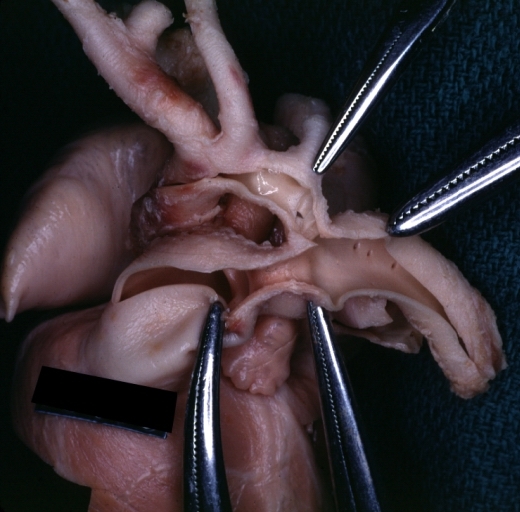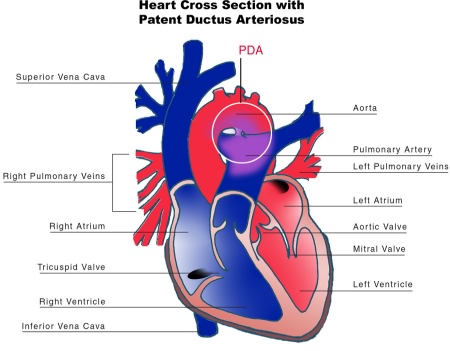Patent ductus arteriosus (patient information)
For the WikiDoc page for this topic, click here
| Patent ductus arteriosus (patient information) | ||
 | ||
|---|---|---|
| Patent Ductus Arteriosus: Gross; a good example in infant. Image courtesy of Professor Peter Anderson DVM PhD and published with permission © PEIR, University of Alabama at Birmingham, Department of Pathology | ||
| ICD-10 | Q25.0 | |
| ICD-9 | 747.0 | |
| OMIM | 607411 | |
| DiseasesDB | 9706 | |
| MedlinePlus | 001560 | |
| eMedicine | emerg/358 | |
| MeSH | C14.240.400.340 | |
Editor-In-Chief: C. Michael Gibson, M.S., M.D. [1]; Jinhui Wu, MD
Please Join in Editing This Page and Apply to be an Editor-In-Chief for this topic: There can be one or more than one Editor-In-Chief. You may also apply to be an Associate Editor-In-Chief of one of the subtopics below. Please mail us [2] to indicate your interest in serving either as an Editor-In-Chief of the entire topic or as an Associate Editor-In-Chief for a subtopic. Please be sure to attach your CV and or biographical sketch.
What is patent ductus arteriosus?

Patent ductus arteriosus is a congenital heart disease in which a blood vessel called the ductus arteriosus fails to close normally in an infant soon after birth. This condition leads oxygen-rich blood from the aorta to mix with oxygen-poor blood from the pulmonary artery. Some studies show German measles infection and genetic disorder may play an important role in the cause of patent ductus arteriosus. Usual signs and symptoms include fast breathing, poor feeding habits, shortness of breath, sweating while feeding and fatigue. Echocardiogram and electrocardiogram can show the enlarged left ventricle in patients with patent ductus arteriosus. Treatments include medicines, catheter-based procedures, and surgery. The prognosis of patent ductus arteriosus depends on the size of patent ductus arteriosus and the effect of medicines, catheter-based procedures or surgery.
How do I know if I have patent ductus arteriosus and what are the symptoms of patent ductus arteriosus?
Infants with patent ductus arteriosus may have symptoms such as:
- Bounding pulse
- Fast breathing
- Poor feeding habits
- Shortness of breath
- Sweating while feeding
- Fatigue
- Poor growth
Other health problems may also cause these symptoms. Only a doctor can tell for sure. A person with any of these symptoms should tell the doctor so that the problems can be diagnosed and treated as early as possible.
Who is at risk for patent ductus arteriosus?
Like many congenital heart disease, the cause of patent ductus arteriosus is not clear. Clinical studies suggest that the genetic and environmental factors both play an important role during the pregnancy.
- Genetic disorders such as Down syndrome
- Pregnant woman had German measles during pregnancy
How to know you have patent ductus arteriosus?
- Echocardiogram: This kind of painless test can help the doctor closely examine patent ductus arteriosus. It uses sound waves to produce an image of the ventricles, atrium and great vessles. Echocardiogram can tell whether ductus arteriosus opens to let blood flow through or not. Further more, the doctor can measure the speed of blood flow through patient's heart and ductus arteriosus area by echocardiogram.
- Chest x-ray: An x-ray image of chest allows the doctor to check the size and shape of your heart to determine whether the left atrium and ventricle are enlarged or not. And it also helps the doctor check the condition of your lungs. Patients with patent ductus arteriosus may show congestive lungs and enlarged left ventricle on an x -ray.
- Electrocardiogram (ECG) and Holter monitoring: Electrocardiogram and Holter monitoring can tell electric activities of the heart for cardiovascular diseases. They can supply information about heart rhythm and indirectly, heart size. Patients with patent ductus arteriosus may show a heart rhythm irregularity such as atrial fibrillation and enlarged left ventricle.
When to seek urgent medical care?
Call your health care provider if your baby has patent ductus arteriosus and symptoms do not improve with treatment, or if new symptoms appear. If your baby experiences either of the following symptoms, seeking urgent medical care as soon as possible:
Treatment options
Patients with patent ductus arteriosus have many treatment options. The selection depends on the size of patent ductus arteriosus, symptoms and whether the child occurs the complications or not. The options are medicines, catheter-based procedures, and surgery. The goal of treatment is to close the patent ductus arteriosus to prevent complications and reverse the effects of increased blood volume. Before treatment starts, ask your health care team about possible side effects and how treatment may change the normal activities. Talk to your child's doctor about treatment options and your family's preferences on treatment decisions.
- Small patent ductus arteriosus often closes without treatment.
- Medicines: Some medicines, such as indomethacin and ibuprofenis, can help close patent ductus arteriosus in premature infants.
- Catheter-based procedures: In a catheter room, the doctor threads a thin tube through a blood vessel in your baby's arm or groin to an artery in the heart and injects dye to see the heart and the arteries on an x-ray. Then a small metal coil or other blocking device is passed up through the catheter and placed in the patent ductus arteriosus to block blood flow through the vessel. Complications of catheter-based procedures may include bleeding, infection and movement of the blocking device from where it was placed. But they are rare and short term.
- Surgery: Surgical treatment of patent ductus arteriosus may be performed on older children even if they have no symptoms because the patent ductus arteriosus will not close by itself. Also, when the catheter procedure does not work or cannot be used, surgery may be needed. During the surgery, the anesthetist gives medicine to make the child sleepy and comfortable. Then the surgeons make a small cut between the ribs to reach the patent ductus arteriosus and close it with stitches or clips. Complications from surgery include hoarsenss, a paralyzed diaphragm, infection, bleeding, or fluid buildup around the lungs. But they are rare and short term.
Diseases with similar symptoms
- Congenital aorticopulmonary septal defect
- Ventricular septal defect
Where to find medical care for patent ductus arteriosus?
Directions to Hospitals Treating patent ductus arteriosus
Prevention of patent ductus arteriosus
Although the cause is unknown, the following measures may be helpful to decrease the risk of having a baby with patent ductus arteriosus.
- Screening test and regular check for people with genetic disorders
- Pregnant woman need to avoiding German measles infection during pregnancy.
What to expect (Outook/Prognosis)?
Prognosis of patent ductus arteriosus varies widely. It depends on:
- The size of patent ductus arteriosus
- Whether the patient has been treated with closure medicines.
- Whether surgery has been done.
- Whether the patient with complications or not, such as heart failure, problems with lung development, or infective endocarditis.
Copyleft Sources
http://www.nlm.nih.gov/medlineplus/ency/article/001560.htm
http://www.nhlbi.nih.gov/health/dci/Diseases/pda/pda_what.html